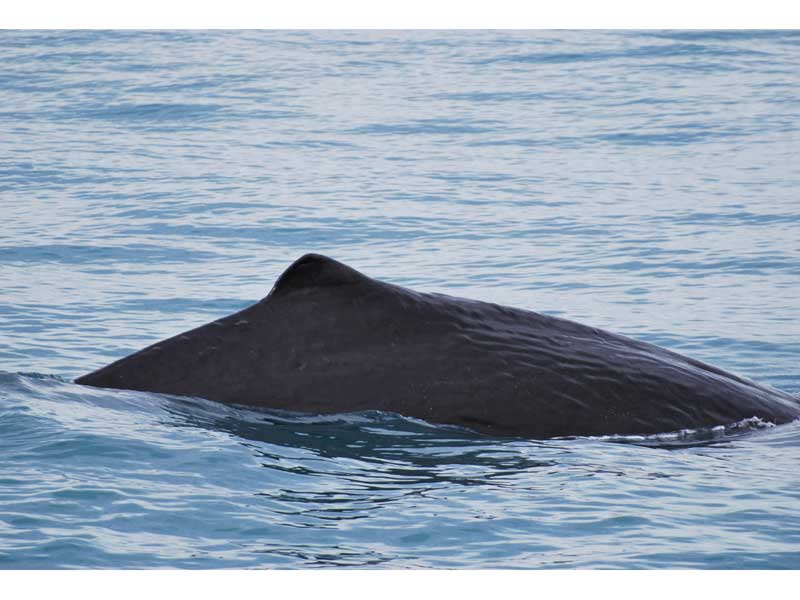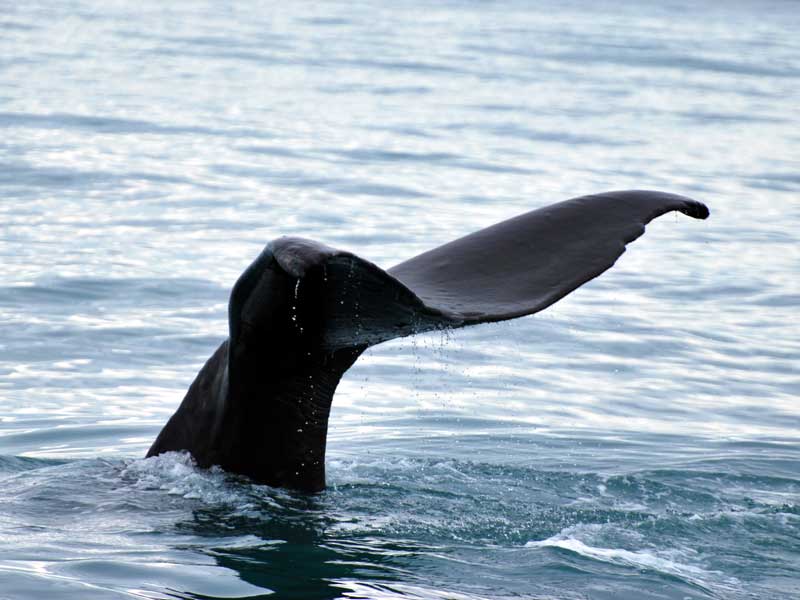Sperm whale (Physeter macrocephalus)
Distribution data supplied by the Ocean Biodiversity Information System (OBIS). To interrogate UK data visit the NBN Atlas.Map Help
| Researched by | Morvan Barnes | Refereed by | Admin |
| Authority | Linnaeus, 1758 | ||
| Other common names | - | Synonyms | Physeter macrocephalus , Physeter macrocephalus Linnaeus, 1758 |
Summary
Description
Recorded distribution in Britain and Ireland
Found off the coasts of northern Scotland, in the north North Sea and off the western coasts of Ireland, although individuals have been washed up at various other locations around the coasts of Britain.Global distribution
-Habitat
The sperm whale is an oceanic deep-sea species that may dive down to a few kilometers in depth.Depth range
-Identifying features
- Up to 18 m in length.
- Small dorsal hump two-thirds down the body followed by smaller humps.
- Large square head up to 30% of the body length.
- Narrow lower jaw with a white inside colouring to the mouth.
- S-shaped blowhole at the front left side of the head.
- About 20 peg-like teeth in each side of the lower jaw.
Additional information
Sperm whales are usually found in medium to large groups of up to 50 individuals, although bulls are sometimes seen alone. The blow is unique amongst whales by being obliquely forward directed. The tail flukes will often appear before a deep dive. Dives may last up to 2 hours long (Kinze, 2002).Listed by
Bibliography
Bruyns, W.F.J.M., 1971. Field guide of whales and dolphins. Amsterdam: Publishing Company Tors.
Howson, C.M. & Picton, B.E., 1997. The species directory of the marine fauna and flora of the British Isles and surrounding seas. Belfast: Ulster Museum. [Ulster Museum publication, no. 276.]
Jefferson, T.A., Leatherwood, S. & Webber, M.A., 1994. FAO species identification guide. Marine mammals of the world. Rome: United Nations Environment Programme, Food and Agriculture Organization of the United Nations.
Kinze, C. C., 2002. Photographic Guide to the Marine Mammals of the North Atlantic. Oxford: Oxford University Press.
Reid. J.B., Evans. P.G.H., Northridge. S.P. (ed.), 2003. Atlas of Cetacean Distribution in North-west European Waters. Peterborough: Joint Nature Conservation Committee.
Smith, T.D. (ed.), 2008. World Whaling Database: Individual Whale Catches, North Atlantic. In: M.G Barnard & J.H Nicholls, HMAP Data Pages. www.hull.ac.uk/hmap, 2008-03-13
Datasets
Cofnod – North Wales Environmental Information Service, 2018. Records of Invasive Non Native Species held on the Cofnod database. Occurrence dataset: https://doi.org/10.15468/nxdbhu accessed via GBIF.org on 2018-09-25.
Environmental Records Information Centre North East, 2018. ERIC NE Combined dataset to 2017. Occurrence dataset: http://www.ericnortheast.org.ukl accessed via NBNAtlas.org on 2018-09-38
NBN (National Biodiversity Network) Atlas. Available from: https://www.nbnatlas.org.
Norfolk Biodiversity Information Service, 2017. NBIS Records to December 2016. Occurrence dataset: https://doi.org/10.15468/jca5lo accessed via GBIF.org on 2018-10-01.
North East Scotland Biological Records Centre, 2017. NE Scotland marine mammal records 1800-2010. Occurrence dataset: https://doi.org/10.15468/suphju accessed via GBIF.org on 2018-10-01.
OBIS (Ocean Biodiversity Information System), 2025. Global map of species distribution using gridded data. Available from: Ocean Biogeographic Information System. www.iobis.org. Accessed: 2025-08-08
Outer Hebrides Biological Recording, 2018. Vertebrates (except birds, INNS and restricted records), Outer Hebrides. Occurrence dataset: https://doi.org/10.15468/dax3tf accessed via GBIF.org on 2018-10-01.
The Mammal Society., 2017. National Mammal Atlas Project, online recording. Occurrence dataset: https://doi.org/10.15468/i2eosa accessed via GBIF.org on 2018-10-02.
Whale and Dolphin Conservation, 2018. WDC Shorewatch Sightings. Occurrence dataset: https://doi.org/10.15468/9vuieb accessed via GBIF.org on 2018-10-02.
Citation
This review can be cited as:
Last Updated: 24/06/2008




